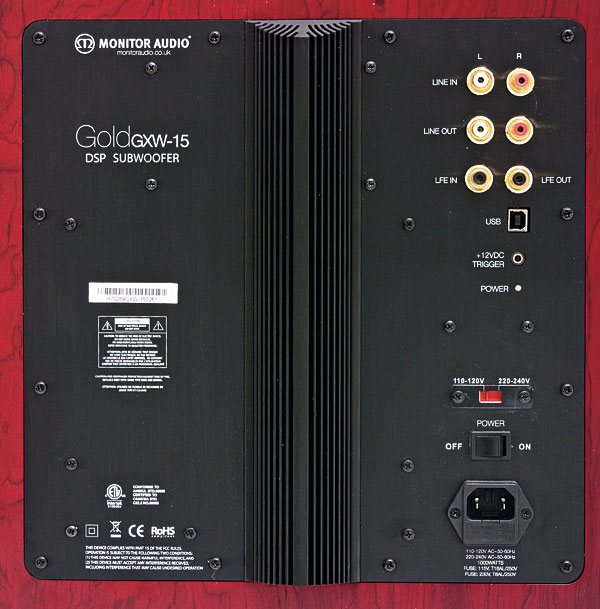Was really looking for a Gx50 review and here we go!
Just wondering about male and female voices: how do they sound ?
Thanks.
 If you’ve struggled with the auto setup functions in A/V receivers and certain subwoofers, you’ll be relieved to hear that LEO is as simple as sub room correction gets. I strung the setup mike to the prime seating position and placed it on a tripod. Since it didn’t have a threaded insert, I just wound the cable around the top of the tripod and situated the mike on the platform as best I could. I held down the remote’s Cal (Calibration) button for three seconds and saw “Cal” appear on the sub display.
If you’ve struggled with the auto setup functions in A/V receivers and certain subwoofers, you’ll be relieved to hear that LEO is as simple as sub room correction gets. I strung the setup mike to the prime seating position and placed it on a tripod. Since it didn’t have a threaded insert, I just wound the cable around the top of the tripod and situated the mike on the platform as best I could. I held down the remote’s Cal (Calibration) button for three seconds and saw “Cal” appear on the sub display.
A few seconds of test tones followed, then the display reverted to its usual red dot. The sub was ready for use.
Associated equipment included a Rotel RSX-1550 A/V receiver, OPPO BDP-83SE universal disc player, Rega Planar 25 turntable, Shure M97xE phono cartridge, and Bellari VP530 tube phono preamp.
Treble Cornucopia
Game of Death (Blu-ray Disc, DTS-HD Master Audio) stars Wesley Snipes as a virtuous CIA hit man caught up in a high-stakes game of greed and betrayal. In less violent moments, the movie activated the Monitor ribbon’s full and extended high-frequency response in a manner that was surprisingly smooth and sweet. As glass shattered and gunshots got louder and more frequent, all the treble information became almost too much of a good thing. It was most listenable at moderate volumes. Dispersion from the ribbon tweeters was excellent throughout, letting me catch dialogue regardless of where I migrated on the sofa. In the course of multiple movie demos, I migrate a lot.
The Covenant (BD, highresolution PCM) is about teens with supernatural powers—addressing feelings of powerlessness as many movies and TV shows have done since the economy went south. The plot’s irrelevance is acknowledged by the casual recording of dialogue, which tested the Monitors’ dialogue-delivery powers to their utmost. But I didn’t miss a single banal word.

Just as I regularly return to, say, the symphonies of Beethoven, I also have a chronic addiction to Star Trek (as well as a pocketful of free non-new-release rental coupons from Blockbuster). And so it was that Star Trek: Insurrection (DVD, DTS) found its way into the OPPO. The ribbon tweeters handled the old-school lossy-encoded soundtrack with aplomb, revealing its true nature, but not too cruelly. The orchestral score sounded as good as it could have under these circumstances. Vocal clarity was outstanding—don’t actors always sound better in space? Swooshing weapon trajectories, especially those moving forward from the surround to the front channels, scared the stuffing out of me.
Throughout the movie demos, the subwoofer handled aggressive effects like a pro, achieving a fine balance of low bass extension and control. I liked it in both Music and Movie modes, although Impact was too much of a good thing. Music firmed up the lowest bass effects, while Movie lent slightly more prominence to the midbass. Despite their differing approaches, both benefited enormously from the LEO sub EQ, which mitigated my room’s midbass hump. EQ on/off mattered more to the net effect than the choice of bass preset.
Sax on Wax
Desmond Blue is one of my treasures, a vintage 1962 RCA Living Stereo LP unearthed (along with hundreds of others) at New York’s now-gone Tower Annex. Two GX50s operating in stereo combined with the tubed phono preamp to conjure magic from this period vinyl. Amazon user reviews of the CD release either love it or hate it, but none of them refers to the peculiarity of the mix, which shoves the scraping strings hard-left while Desmond’s suave alto sax blows mellifluously just right of center. In contrast to the spatially limited strings, the sax was like an undulating three-dimensional living thing—in fact, it reminded me of the jellyfish in the New England Aquarium in Boston, with holographic imaging and a lush, golden smoothness. Cruder speakers would have leaned to one side or the other, emphasizing either the rawness of the strings or the sweetness of the sax. Monitor managed to hold both these truths in the palm of its hand simultaneously. This was a deeply pleasurable and enlightening experience.

Best-case demo material was Tchaikovsky’s Symphony No. 5 on a PentaTone SACD circa 2010. The Russian National Orchestra—the first founded in post-Soviet Russia—was conducted by its founder Mikhail Pletnev. Right from the opening moments, with clarinet borne aloft by strings, I was entranced. The speakers favored some instruments over others. Whenever reeds or woodwinds emerged from the mix, it always felt like a special occasion, with a good balance between midrange solidity and high-frequency detail. Strings were pleasingly detailed at low to moderate volumes, although at their highest swells, their treble richness sometimes sounded like too much information. These speakers have a definite personality. The overall feel was vibrant and challenging, not mellow or laid-back.
That a revealing speaker can be a two-edged sword became all too obvious with A Pile of Rock: Live by Dave Edmunds. Not that the bandleader’s rocking ability was anything less than confident or his Telecaster anything less than incisive. But the speakers turned his voice—even in a high-resolution DVD-Audio release—into a tinny specter, and I couldn’t enjoy this live album at anything greater than a low volume level. Cue Jack Nicholson: You can’t handle the truth!
The Monitor Audio GX Gold speakers are for the questing audiophile who wants to transcend the limitations of runof-the-mill dome-based tweeters and low-tech woofers. While they can be fussy about your choice of content, please don’t get the impression that these speakers are the kind that make a few things sound amazing and most others sound nasty. They loved great content, but when they protested against substandard content, the main consequence was a need for lower volume, as opposed to sheer lack of musicality.
Special commendation goes to the GXW-15 subwoofer, one of the most cleverly designed I’ve ever reviewed. Its LEO room correction makes a difference yet requires no particular technical expertise to set up. The inclusion of a remote with preset EQ modes is inspired. As compelling as the speakers are in their own right, the sub is even more so for its advanced design and features.

Was really looking for a Gx50 review and here we go!
Just wondering about male and female voices: how do they sound ?
Thanks.


Hi Scott, thank you for your comment. You are perfectly right: vocals were commented for both movies (where clarity and resolution could be appreciated) and music (where, for this live piece of Rock music, I understand that at high volume the speakers turned to be a bit too much revealing or even harsh with respect to the singer's voice).
Good to know that in general there was nothing bad to mention about female & male vocals.
Great review!